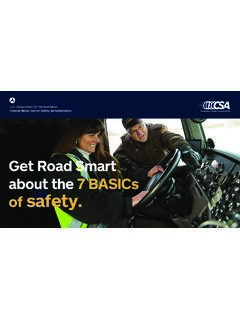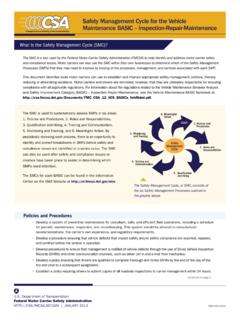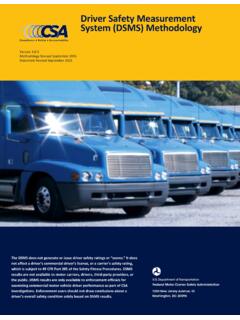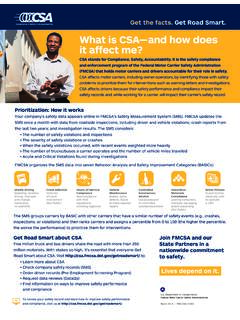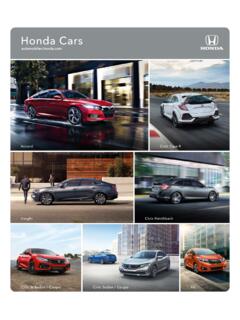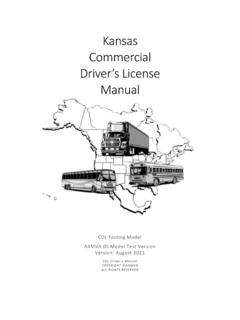Transcription of KNOW HE FACTS: UPDATES TO HOURS OF SERVICE RULES
1 KNOW THE FACTS: UPDATES TO HOURS OF SERVICE RULESHOURS OF SERVICE FINAL RULE On June 1, 2020, the Federal Motor Carrier Safety Administration (FMCSA) published the HOURS of SERVICE final rule that revises the HOS regulations in 49 CFR Part 395, which prescribe driving limits for commercial motor vehicle (CMV) rule includes four changes designed to offer drivers greater flexibility, while maintaining the highest safety standards on our Nation s roads, and was developed based on extensive public and industry Asked Questions ZZZWhat s Changing?Short-Haul ExceptionThe short-haul exception maximum allowable workday is changing from 12 to 14 HOURS , and the distance the driver may operate is extending from a 100 air-mile radius to a 150 air-mile radius. Adverse driving Conditions ExceptionThe adverse driving conditions exception is extending the duty day by up to two HOURS when adverse driving conditions are encountered. This is in addition to the extra two HOURS of driving time already change applies for both property (14-hour driving window) and passenger (15-hour on-duty limit) motor carriers.
2 30-Minute Break RequirementThe 30-minute break requirement can now be satisfied by an on-duty, not driving break (in addition to an off-duty break). The requirement for property-carrying drivers is applicable in situations where a driver has driven for a period of 8 HOURS without at least a 30-minute Berth ProvisionThe sleeper berth provision allows drivers to split their 10-hour off-duty period in different ways ( , 7/3, 8/2, ), provided one off-duty period (whether in or out of the sleeper berth) is at least 2 HOURS long, and the other involves at least 7 consecutive HOURS spent in the sleeper berth. The periods must add up to 10 HOURS , and when used together, neither time period counts against the maximum 14-hour driving do the changes take effect?Drivers and carriers must operate under the HOURS of SERVICE (HOS) final rule starting on September 29, 2020, and not are the regulations changing?The revised HOS regulations will provide greater flexibility for drivers without adversely affecting safety, and are based on thousands of comments FMCSA received from industry, safety advocacy groups, Congress, and the American addition, FMCSA s rule modernizing HOURS of SERVICE regulations is estimated to provide nearly $274 million in annualized cost savings for the the changes affect my Electronic Logging Device?
3 The minimum requirements in the Electronic Logging Device (ELD) final rule do not require ELDs to identify HOURS of SERVICE violations; however, some ELD providers have elected to offer this as an add-on feature. If an ELD provider offers this add-on feature, but does not update their device to reflect the new HOURS of SERVICE RULES , the ELD may inaccurately identify HOURS of SERVICE violations. Motor carriers should contact their ELD provider with specific questions about what information their ELD : of-serviceEmail: September 2020 HOURS OF SERVICE (HOS) FACT SHEETSHORT-HAUL EXCEPTIONHOURS OF SERVICE FINAL RULE On June 1, 2020, the Federal Motor Carrier Safety Administration (FMCSA) published the HOURS of SERVICE final rule that revises the HOS regulations in 49 CFR Part 395, which prescribe driving limits for commercial motor vehicle (CMV) rule includes four changes designed to offer drivers greater flexibility, while maintaining the highest safety standards on our Nation s roads, and was developed based on extensive public and industry Exception and Electronic Logging Devices/LogbooksWhile operating under the short-haul exception, drivers are permitted to keep a time record instead of recording time in a graph grid or with an Changes 14 Short-Haul ExceptionAdverse driving Conditions Exception30-MinuteBreakSleeper Berth Provision23 Changes to the Short-Haul ExceptionThis factsheet explains the differences between the short-haul exception under the previous HOS rule and the new rule that takes effect on September 29, and passenger carriers using the short-haul exception in (e)(1) are not required to take a 30-minute break from driving , and are permitted to record HOURS in a time record, rather than a graph grid log or electronic logging device (ELD).
4 Short-haul operators can drive within a larger air-mile radius and have a longer duty-period under the new other provisions of the (e)(1) short-haul exception have changed, nor has the non-CDL short-haul exception in (e)(2) (property-carrying). Time must include the totaltime for the 7 preceding daysfor new hires or drivers usedintermittently ( (j)(2)) Records must be maintainedfor 6 monthsIf a driver is required to complete a log for: 8 or fewer days within the last 30 days,a driver can use a paper log with agraph grid or an ELD More than 8 days within the last 30days, a driver generally must use anELD to record time for that day Drive within a 100 air-mile radius Do not exceed a maximum on-duty period of 12 HOURS Start and end shift in the same location Have at least 8 HOURS off (passenger carrier) or 10 HOURS off (property carrier) between duty periodsPreviousNew Drive within a 150 air-mile radius Do not exceed a maximum on-duty period of 14 HOURS Start and end shift in the same location Have at least 8 HOURS off (passenger carrier) or 10 HOURS off (property carrier) between duty periodsWhen using the short-haul exception, the motor carrier must record the driver s time in, time out, and total number of HOURS per dayWhen a driver no longer meets the short-haul exception (drives too far/works too many HOURS )
5 , the driver must complete a regular log or use an ELD for the day ( )Web: of-serviceEmail: September 2020 Examples on reverseSHORT-HAUL EXCEPTIONHOS Changes 14 Short-Haul ExceptionAdverse driving Conditions Exception30-MinuteBreakSleeper Berth Provision23 Example No Violation In this example, the property-carrying driver has taken 10 consecutive HOURS off-duty before coming on-duty at midnight and being released from duty at 2 During that time, the driver drove for 9 HOURS , and spent the remaining time on breaks or on-duty, not driving . The driver returned to the normal work reporting location at 2 , was released within 14 consecutive HOURS , and stayed within a 150 air-mile Time (All)End Time (All)Total HoursDriving HoursTruck NumberStart LocationEnd Location5/7/2012: 00 am2:00 Main St Burbank, CA123 Main St Burbank, CADateStart Time (All)End Time (All)Total HoursDriving HoursTruck NumberStart LocationEnd Location5/7/2012: 00 am3:00 Main St Burbank, CA900 Smith St Pasadena, CA Violation In this example, the property-carrying driver has taken 10 consecutive HOURS off-duty before coming on-duty at midnight.
6 The driver drove for 10 HOURS , and spent the remaining HOURS on breaks or on-duty, not driving . The driver was released at 3:00 from a location that was different from the normal work reporting location where the shift began. Since the driver drove 1 hour past the 14-hour limit, and did not return to the reporting location within that time, the motor carrier is in : of-serviceEmail: September 2020 HOURS OF SERVICE (HOS) FACT SHEETADVERSE driving CONDITIONSHOURS OF SERVICE FINAL RULEOn June 1, 2020, the Federal Motor Carrier Safety Administration (FMCSA) published the HOURS of SERVICE (HOS) final rule that revises the HOS regulations in 49 CFR Part 395, which prescribe driving limits for commercial motor vehicle (CMV) rule includes four changes designed to offer drivers greater flexibility, while maintaining the highest safety standards on our Nation s roads, and was developed based on extensive public and industry driving Conditions Exception ChangesThis fact sheet explains the differences between the adverse driving conditions exception under the previous HOS rule and the new rule that takes effect on September 29, unforeseen adverse driving conditions affect their route, drivers can:The definition of adverse driving conditions now considers the role of the driver.
7 Example No Violation Calculation of the 11- and 14-hour limits for this property carrierbegin at midnight after the driver hastaken 10 consecutive HOURS off-dutyon the prior day. The driver drives for 3hours, is off-duty for 1 hour, drives for4 HOURS , and is on-duty for 1 hour. Thedriver then hears that a bridge on theroute ahead is closed due to a gravel spill,and the bridge is the only way to get tothe destination. The driver takes 1-hour off-duty from 9 to 10 to wait at a rest areawhile the bridge is cleared, then drives for 5 more HOURS to the destination. This results in thedriver driving for 12 HOURS , and also operating beyond the 14-hour driving window by 1 hourbetween 2 and 3 There is no violation of either the 11- or 14-hour limits under thenew HOS final rule when using the adverse driving conditions for up to 2 HOURS beyond the driving limits Property carrier 11-hour driving limit Passenger carrier 10-hour driving limitAdverse driving conditions means snow, sleet, fog, or other adverse weather conditions, a highway covered with snow or ice, or unusual road and traffic conditions, none of which were apparent on the basis of information known to the person dispatching the run at the time it was begun.
8 PreviousPrevious2-hour extensionapplies to bothdriving limit andon-duty limitAdverse driving conditions means snow, ice, sleet, fog, or other adverse weather conditions or unusual road or traffic conditions that were not known, or could not reasonably be known, to: a driver immediately prior to beginning the duty day or immediately before beginning driving after a qualifying rest break or sleeper berth period, or a motor carrier immediately prior to dispatching the using adverse driving conditions exception, drivers can drive up to:NewNewWeb: of-serviceEmail: June 2020 HOS Changes 21 Short-Haul ExceptionAdverse driving Conditions Exception30-MinuteBreakSleeper Berth Provision43 Property carrier 11-hour driving limit and 14-hour driving window (a)(2) Passenger carrier 10-hour driving limit and 15-hour on-duty limit (a)(2) Property: 13 HOURS within a 16-hour driving window Passenger.
9 12 HOURS within a 17-hour on-duty period5 June11 hrs0 hrs12 hrs1 hrsHOURS OF SERVICE (HOS) FACT SHEET30-MINUTE BREAKHOURS OF SERVICE FINAL RULEOn June 1, 2020, the Federal Motor Carrier Safety Administration (FMCSA) published the HOURS of SERVICE (HOS) final rule that revises the HOS regulations in 49 CFR Part 395, which prescribe driving limits for commercial motor vehicle (CMV) rule includes four changes designed to offer drivers greater flexibility, while maintaining the highest safety standards on our Nation s roads, and was developed based on extensive public and industry Break Changes This fact sheet explains the difference between how the 30-minute break requirement is satisfied under the previous HOS rule and the new rule that takes effect on September 29, (a)(3)(ii), property-carrying CMV drivers are required to take a 30-minute break after:Examples No Violation After 10 HOURS off-duty the driver comes on-duty at midnight and drives for 5 HOURS , goes on-duty (not driving ) for a hour, drives for 5 more HOURS , goes on-duty (not driving ) for 1 hour, drives for 1 hour, goes on-duty (not driving ) for 1 HOURS , and then takes 10 consecutive HOURS off-duty.
10 Under the new HOS rule, the 30-minute on-duty break taken between 5 and 5:30 will suffice for the mandatory 30-minute break, and the property-carrying driver is allowed to drive up to the maximum of 11 HOURS (6 more HOURS in this example), before needing 10 consecutive HOURS off-duty. Violation There is a violation between 9 and 9:30 After 10 HOURS off-duty, the driver comes on-duty (not driving ) at midnight for 1 hour, drives for 8 HOURS , goes on-duty (not driving ) for a hour, drives for 2 HOURS , goes off-duty for 1 hour, goes on-duty (not driving ) for a hour, drives for a hour, and then takes 10 consecutive HOURS off-duty. The violation occurs at 9 , as the driver drives for more than 8 consecutive HOURS without at least a 30-minute rest break. A consecutive 30-minute interruption of driving status may be satisfied either by off-duty, sleeper berth, or on-duty (not driving ) time; or by a combination of off-duty, sleeper berth, and on-duty (not driving ) time.
